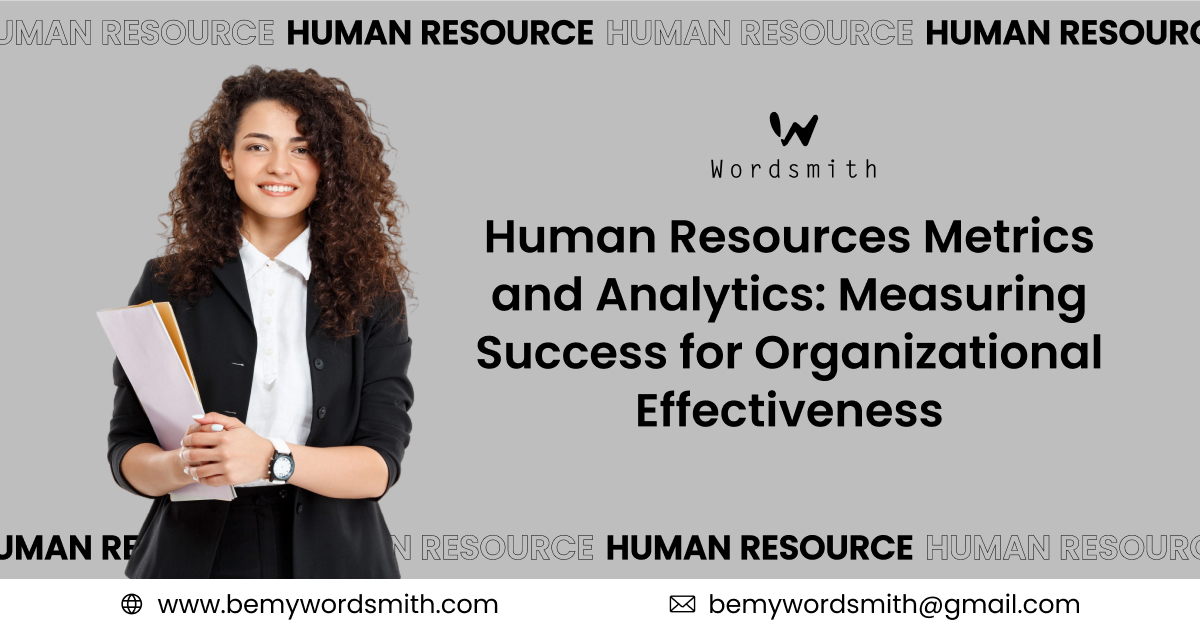Human Resources Metrics and Analytics: Measuring Success for Organizational Effectiveness
Preeti Kumari | 06-07-2024 | 07 min read

Are you eager to take your HR strategy to the next level? Yes, then this article is for you. By utilizing HR analytics and metrics to their full potential, you can obtain priceless knowledge to revolutionize how you promote organizational performance. Be ready to discover data-driven solutions that will advance your company forward! Since these metrics are only used in some organizations, owners, and managers, it is challenging to quantify an HR job. However, using these metrics and analytics, HR performance can be measured and made more tangible. Metrics and analytics are a powerful combination that can enable your HR team to organize their workforce more efficiently, make better decisions, and show the actual results of your efforts.
This article will empower you with the information and resources you need to measure and succeed in the constantly changing HR industry. Whether you're an HR professional looking to improve your analytical abilities or a company leader trying to comprehend the impact of HR metrics, Understanding the importance of HR analytics and metrics will help you realize their relevance in today's industrial environment. The metrics and analytics will reveal your company's health, from employee engagement and training efficacy to workforce productivity and talent retention. Use the HR metrics to pinpoint areas for development, strategically assign resources, and highlight your HR department's contributions.
What are HR Metrics and Analytics?
HR Metrics are simply data points related to various HR functions. See them as the "what" in your HR data- quantifiable, measurable, and trackable. For example, cost per hire and time to hire.
On the other hand, HR analytics examines these data to find patterns, trends, and insights. It’s about knowing the "why" behind the metrics and making well-informed decisions. For example:
- Why does a specific department have a high turnover rate?
- What aspects of specific roles make hiring decisions more quickly than others?
- What is the effect of employee engagement on total productivity?
Importance of HR metrics and analytics
Consider HR analytics and metrics as the fitness tracker for your HR department. These measures measure critical components of the HR department to maintain your business in top form, just as a fitness tracker monitors your steps, heart rate, and sleep to help you stay healthy.
These measurements assist you in seeing both the big and small picture. Examples include;
- Employee satisfaction and engagement levels
- The number of individuals joining or departing your business.
- The effectiveness of your training initiatives.
They function similarly to a dashboard that indicates what functions correctly and requires attention.
The importance of HR metrics and analytics are:
- Monitor Progress: HR metrics assist you in monitoring your team's progress and identifying areas for development.
- Make Informed Decisions: Robust data empowers you to make more informed choices on recruiting, promotions, and other matters.
- Identify Trends: Data can identify trends, such as factors that increase employee happiness or why individuals quit.
- Save Money: Effective HR procedures result in fewer errors and better resource management, which helps your business save Money.
- Boost Morale: A better understanding of what motivates your team can help foster a more positive and effective work atmosphere.
- Remain Competitive: Maintaining a competitive edge for your business requires adhering to industry norms and benchmarks.
- Improve Training: Determine skill shortages and modify training curricula to fit real-world requirements.
- Improve Recruitment: Identify the most effective hiring practices for attracting top candidates.
- Reduce Turnover: You may create retention plans by determining the reasons behind employee churn.
Key HR Metrics and their Calculation Formulas to Measure Success
- Turnover Rate: Calculates the proportion of workers who quit their jobs within a given time frame. Excessive turnover may indicate problems with management styles, satisfaction with work, or workplace culture.
- Time to hire: Monitors the typical amount of time needed to fill a vacant position, providing insight into the effectiveness of your hiring procedure.
- Employee Satisfaction: This indicator evaluates general employee satisfaction and engagement. It’s frequently measured through surveys.
- Absenteeism Rate: This rate tracks how frequently workers miss work; irregularities in this area may indicate issues at work or morale.
- Training and Development: Evaluate the impact of your training programs and their effect on performance.
- Cost per Hire: This tool helps manage recruitment budgets by calculating the cost of acquiring a new employee.
- Performance and Productivity: Evaluate the output and effectiveness of employees, frequently using productivity measures and performance reviews.
- Retention Rate: Shows how many workers stick with a company for an established period, indicating stability and job satisfaction.
- Internal Promotion Rate: Indicates the proportion of development by tracking the percentage of positions filled by internal candidates.
| Metrics | Formulas |
|---|---|
| Turnover Rate | = (Number of Employees Who Left During the Period / Average Number of Employees During the Period) × 100 |
| Time to hire | = Date of Offer Acceptance − Date Job Requisition Opened |
| Employee Satisfaction | = Sum of all satisfaction scores / Number of respondents × 100 |
| Absenteeism Rate | = (Number of Days Absent / Total Number of Available Workdays) × 100 |
| Training and Development | = (Net Benefits of Training / Cost of Training) x 100 |
| Cost per Hire | = Total Recruitment Costs / Number of Hires |
| Performance and Productivity | = Output / Input |
| Retention Rate | = (Number of employees at the end of the period − Number of new employees during the period / Number of employees at the start of the period) × 100% |
| Internal Promotion Rate | = (Number of Employees Promoted Internally / Total Number of Employees) × 100 |
Leveraging HR analytics to drive business success
- Identify Talent Trends: Use HR analytics to understand the qualities and skills of your top performers. This insight can guide your hiring decisions and help you find similar talent.
- Boost Employee Engagement: Examine engagement statistics to create programs that motivate and satisfy your team.
- Predict and Prevent Turnover: Using data analysis to identify tendencies that result in high turnover, you can implement strategies to keep your best workers.
- Optimize Recruitment: Find out which channel attracts the best candidates so you can concentrate on your efforts and resources efficiently.
- Improve Training Programs: Identify the most effective training sessions and modify your programs to build a more capable staff.
- Improve Workforce Planning: Project future personnel needs using data trends to ensure readiness and avoid being caught off guard by unforeseen developments.
- Measure performance Effectively: Ensure everyone is in sync and working toward the same goals by setting specific, quantifiable goals and utilizing data to measure progress.
- Streamline HR Processes: Identify and develop strategies to improve inefficient HR processes, freeing time and resources for essential tasks.
- Support Informed Decision-Making: Provide data for HR decisions so that stakeholders and leadership would be more willing to support them.
Challenges in Implementing HR Analytics
- Technical Issues: Setting up suitable systems and software for HR analytics can take time and effort.
- Skills Gap: Only some HR professionals are data experts. You should invest in training or hire new talent with the right skills.
- Change Resistance: People can be wary of new processes and tools. It can take time to get everyone on board with using analytics.
- Overload of Data: It is difficult to sort through the vast amount of data available to determine what is meaningful and just noise.
- Quality of Data: Your analytics will only be reliable if your data is organized and included. Accurate and precise data collection can take a lot of work.
- Protective Issues: Strict privacy regulations are necessary when handling sensitive employee data. One mistake might result in serious issues.
- Cost: Setting up and keeping up an HR analytics platform may be expensive, and proving a return on investment can be difficult.
- Consistency: Maintaining consistent data and procedures throughout the company may take time, particularly in more giant enterprises.
The future of HR analytics and metrics
Predictive Insights: Imagine if HR could use data patterns to predict employees likely to succeed or quit. We're moving in that direction—using analytics to predict results and take proactive steps to prevent them.
Customization: HR might customize career routes and growth programs based on individual employee data, similar to how Netflix suggests shows. The goal is to make work more meaningful and personal.
Real-Time Feedback: Eliminate yearly reviews; real-time analytics may provide teams with immediate feedback on engagement and performance, allowing them to make adjustments as needed.
AI and Automation: AI will become more prevalent in decision-making and process optimization. Examples of this include chatbots answering HR inquiries and algorithms screening resumes.
Privacy and Ethics: The necessity for ethical standards regarding the collection and use of employee data is growing along with data usage. Striking a balance between privacy and insights will be critical.
Comprehensive Measures: Future metrics include the diversity effect, environmental initiatives, employee well-being, and numbers representing larger corporate ideals.
Integration with Business Goals: HR analytics will no longer be limited to HR use. They will be highly compatible with the overarching business plan, enabling organizations to accomplish their objectives more efficiently.
Privacy and Ethics: The necessity for ethical standards regarding the collection and use of employee data is growing along with data usage. Striking a balance between privacy and insights will be critical.
Comprehensive Measures: Future metrics include diversity effect, environmental initiatives, employee well-being, and numbers representing larger corporate ideals.
Integration with Business Goals: HR analytics will no longer be limited to HR use. It will be highly compatible with the overarching business plan, enabling organizations to accomplish their objectives more efficiently.
The use of data to improve workplaces and build more contented, productive teams is at the heart of the fascinating future of HR analytics and metrics.
Conclusion
The game has changed with the introduction of machine learning, advanced analytics, and cloud-based HR technology. Due to these advancements, human resources professionals can now collect, analyze, and quickly understand data in previously impossible ways. Instead of just guessing, HR analytics and metrics allow the HR team to make informed decisions. You'll be able to use your time and resources more effectively to raise productivity, lower turnover, or enhance employee happiness.
Human resource metrics, which track employee engagement and exit rates, project future talent requirements, and recruitment efforts, help businesses make better, data-driven decisions. This change has strengthened HR's strategic significance and established it as a vital factor in organizations' success. Accept the people's analytics of the future, and you'll see your company reach new heights of achievement. It's time to unleash the potential of HR analytics and metrics.
For top-notch content writing services designed to maximize conversion, check out Be My Wordsmith.
Popular blogs

Tips to boost organic Ranking and Traffic
Gaining proficiency in techniques to raise organic ranks and increase targeted traffic is essential in the ever...

Tips to boost organic Ranking and Traffic
Gaining proficiency in techniques to raise organic ranks and increase targeted traffic is essential in the ever...

What are Backlinks and what are their purpose in SEO?
Backlinks serve the main purpose of increasing a website's online visibility by raising its search engine ratin...
Submit a Comment